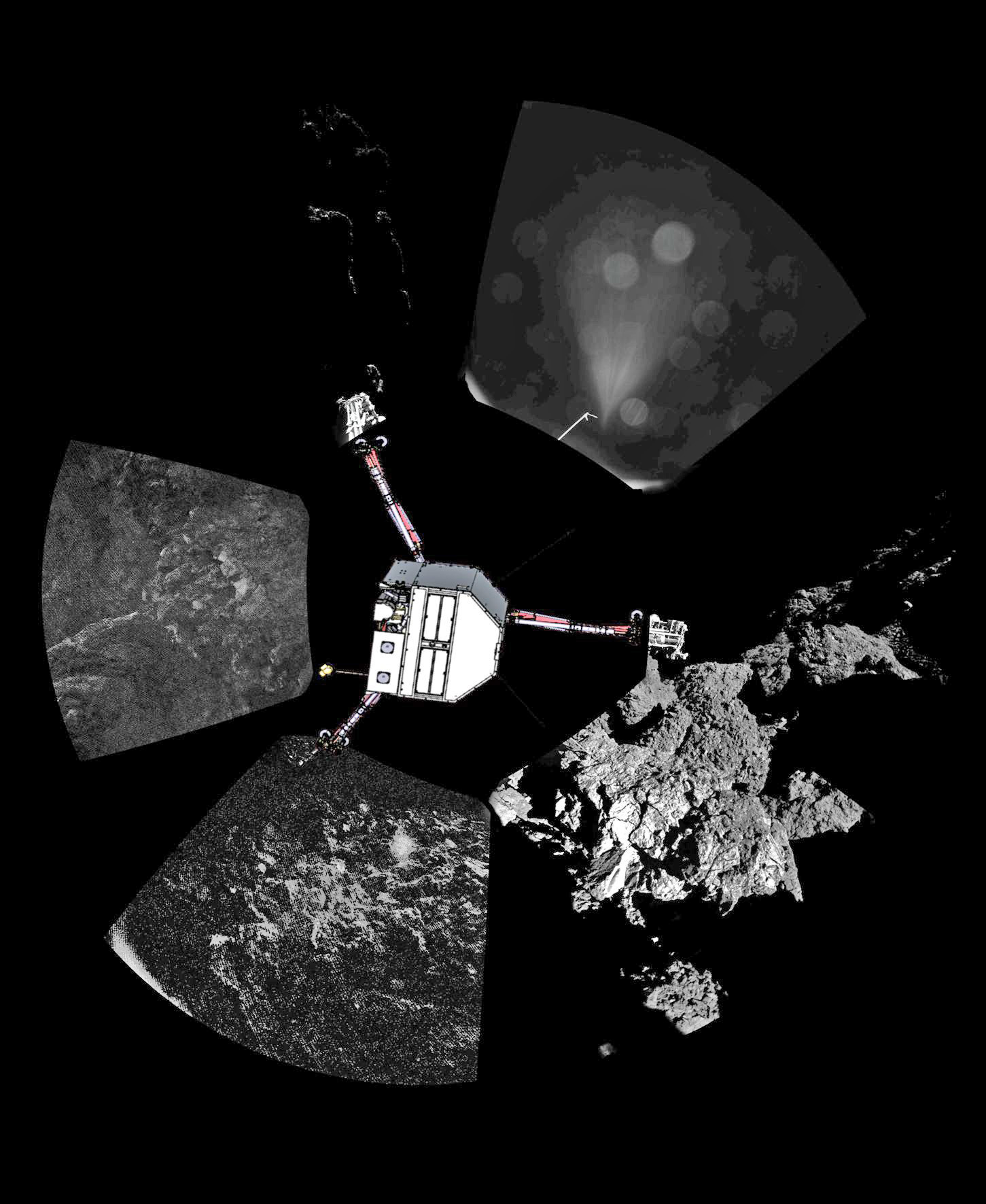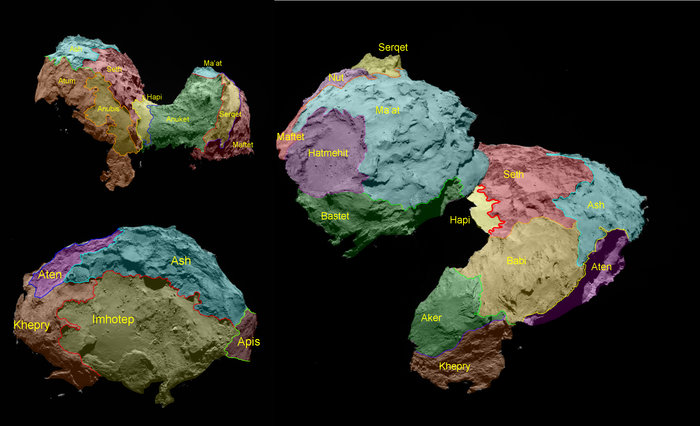
The 19 regions identified on Comet 67P/Churyumov–Gerasimenko are separated by distinct geomorphological boundaries. Following the ancient Egyptian theme of the Rosetta mission, they are named for Egyptian deities. Credit: ESA/Rosetta/MPS for OSIRIS Team MPS/UPD/LAM/IAA/SSO/INTA/UPM/DASP/IDA
Scientists leading Europe’s Rosetta orbiter mission have discovered a wondrous array of rugged surface terrain, mysterious cracks, and jet spewing pits at the dust covered Comet 67P/Churyumov–Gerasimenko, following the spacecraft’s arrival on Aug. 6, 2014, after a decade-long interplanetary journey of some 500 million kilometers (300 million miles) from Earth. Rosetta is on a mission of cutting-edge science to elucidate our origins, and many more exciting discoveries are yet to come.
The European Space Agency’s (ESA) Rosetta/Philae spacecraft is the first mission in human history to orbit and land on a comet. Member states and NASA also contributed instruments to the orbiter and lander.
Prior space-based comet missions have conducted fast flybys, starting with ESA’s Giotto probe to Comet Halley in 1986 and continuing with NASA’s Deep Space 1 at Borrelly; Stardust flyby and sample return at Wild 2; Deep Impact and Stardust NeXT separately at Tempel 1; and EPOXI at Hartley 2.
Now the Rosetta science teams have collectively published the first batch of papers in a special edition of the journal Science, based on initial measurements from seven of the probe’s eleven science instruments made during the approach phase and in the initial few weeks and months after entering orbit around the Jupiter family comet 67P.
A top priority after arriving at the comet—when it was 3.7 astronomical units (AU) from the Sun—was to find a safe and scientifically interesting landing site for the piggybacked Philae comet lander.
The team used the orbiter’s 11 state-of-the-art science instruments to quickly map the bizarre comet whose surface was entirely unknown and which was unexpectedly found to consist of two lobes fused at a narrow neck and was shaped like a rubber ducky!
All the while the comet was moving in closer to the Sun, warming the body and resulting in a pickup of activity and a bigger coma due to sublimation of subsurface ices and spewing gases and dust.
Maps of the comets surface were derived via the high-resolution OSIRIS science camera, which so far has photographed over 70 percent of the pockmarked surface, revealing rocks and house-sized boulders, steep cliff walls, fractures, numerous 3-meter-wide (10-feet) “goosebumps” of unknown origin, pits, depressions, and small patches of ice and carbon rich molecules.
The remaining area not imaged is in the southern hemisphere that was not fully illuminated.
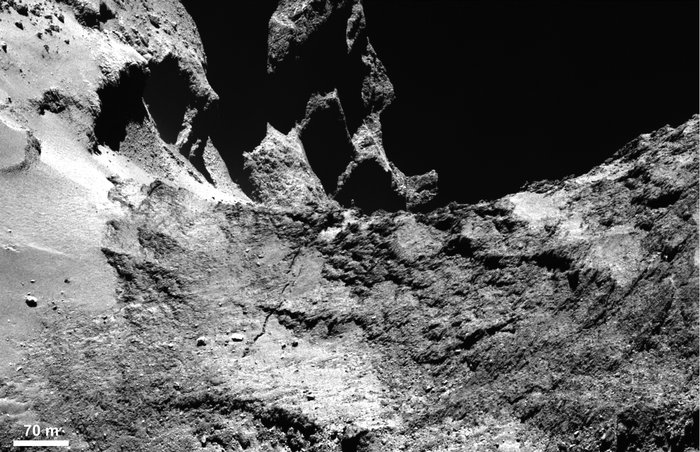
This OSIRIS narrow-angle camera image shows part of a large fracture running across Comet 67P/Churyumov–Gerasimenko’s neck into the Anuket region, Credits: ESA/Rosetta/MPS for OSIRIS Team MPS/UPD/LAM/IAA/SSO/INTA/UPM/DASP/IDA
Ultimately the team whittled down the candidate landing sites to a short list of two. Philae was successfully dispatched to the primary landing site named Agilkia on the head of the nucleus surface on Nov. 12, 2014, when the comet was 3.0 AU from the Sun. Philae had to land while 67P constantly rotates every 12.4 hours.
The refrigerator-sized Philae probe bounced three times before finally coming to rest beside a shaded cliff during the historic touchdown.
The 100-kg (220-lb) lander did accomplish its primary science mission, enduring some 60 hours. The mini laboratory returned images and spectra, sniffed the atmosphere, drilled, hammered, and collected other surface data before entering hibernation due to lack of sufficient sunlight to power up.
The lander team hopes to regain contact as early as this month, if its electronics survived the frigid cold temperatures these past few months. DLR (Deutsche Luft und Raumfahrt or the German Aerospace Agency) leads the consortium funding the lander.
The OSIRIS team is also still conducting a photographic search for Philae.
Using the OSIRIS images, the team identified 19 distinct regions on the surface. They are named for Egyptian deities in keeping with the ancient Egyptian theme of the Rosetta mission and “are grouped according to the type of terrain dominant within,” according to an ESA statement.
The surface regions with marked borders are shown on the imagery above and below.
The 19 regions have been categorized into five distinct types of terrain: dust-covered; brittle materials with pits and circular structures; large-scale depressions; smooth terrains; and exposed more consolidated (“rock-like”) surfaces.
Dust covers much of the northern hemisphere and is several meters thick in places. Much of it comes from sublimated ice that escaped into the coma and subsequently fell back onto the surface when it didn’t achieve escape velocity.
The dust also serves as an insulator for the water ice deposits below.
The images also show discrete jets sprouting from throughout the comet. Imagery shows some jet activity emanating from pits, although most originate from the neck region.
“Activity at a distance from the Sun of >3 astronomical units is predominantly from the neck, where jets have been seen consistently,” says Holger Sierks, principal investigator for Rosetta’s OSIRIS camera from the Max Planck Institute for Solar System Research in Gottingen, Germany, in a Science journal paper.
An intriguing 500-meter-long crack through the neck region, named “Hapi,” was also discovered running “roughly parallel to the neck between the two lobes, although it is not yet known if it results from stresses in this region,” according to the OSIRIS team.
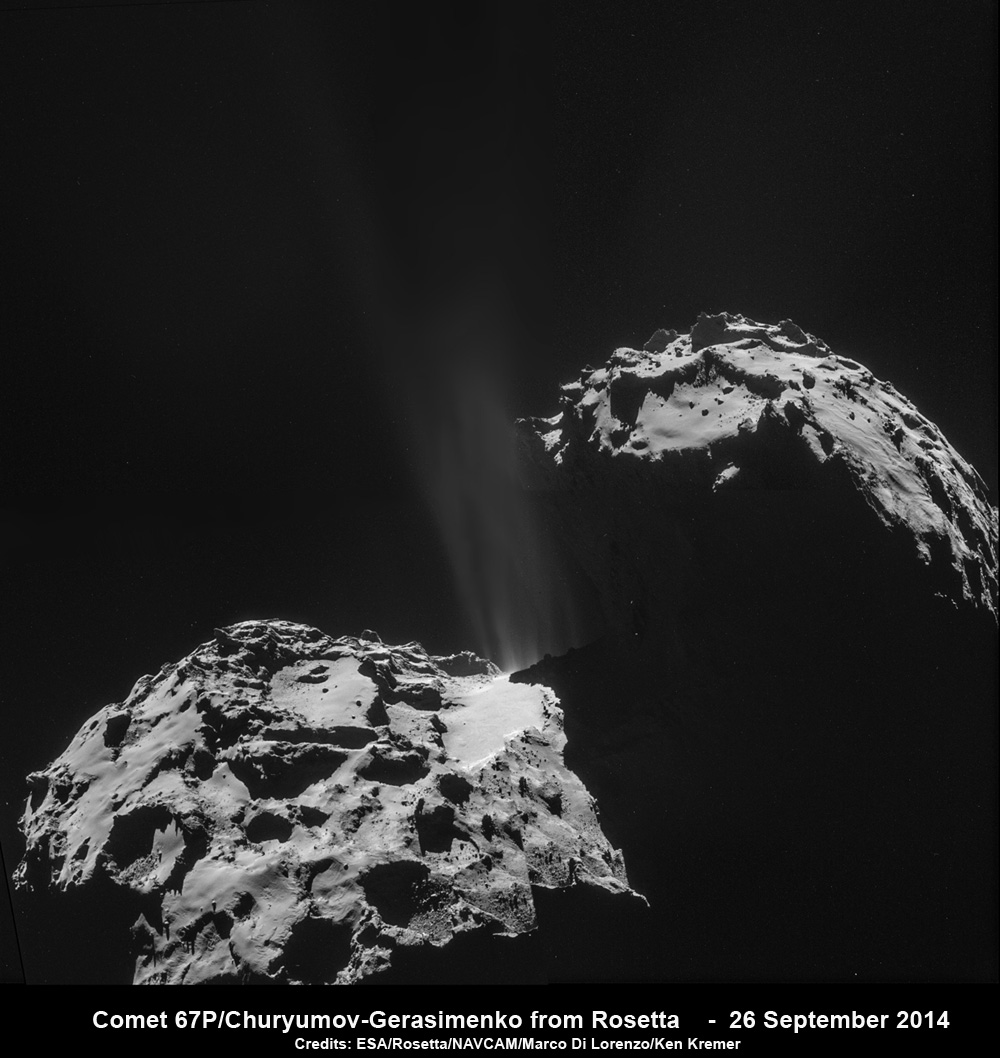
Furthermore, based on the rubber ducky shape itself, the team is pondering “the question of whether the two lobes represent a contact binary formed 4.5 billion years ago, or a single body where a gap has evolved via mass loss.”
Some data points to a similar composition for the two lobes, which would favor the erosion theory from a larger, single body. But the jury is still out, and further studies are in progress to illuminate the scientists’ thinking on the alternative: whether two comets actually smacked together in deep space to form 67P.
Why study comets?
“Comets are the best sample of primitive solar nebula material presently available to us, dating back 4.57 billion years to the origin of our planetary system,” wrote Matt Taylor, the Rosetta project scientist from the European Space Research and Technology Center, Noordwijk, the Netherlands, in the lead Science paper.
“Past missions to comets provided only a snapshot view of the dust and ice nucleus, the nebulous coma surrounding it and how the solar wind interacts with both of these components.”
“Rosetta is now taking a more prolonged look and is uniquely positioned to further the understanding of these primitive bodies, having revealed an unusual and fascinating object.”
Rosetta’s instruments discovered evidence of many active and highly complex processes on the comet’s surface.
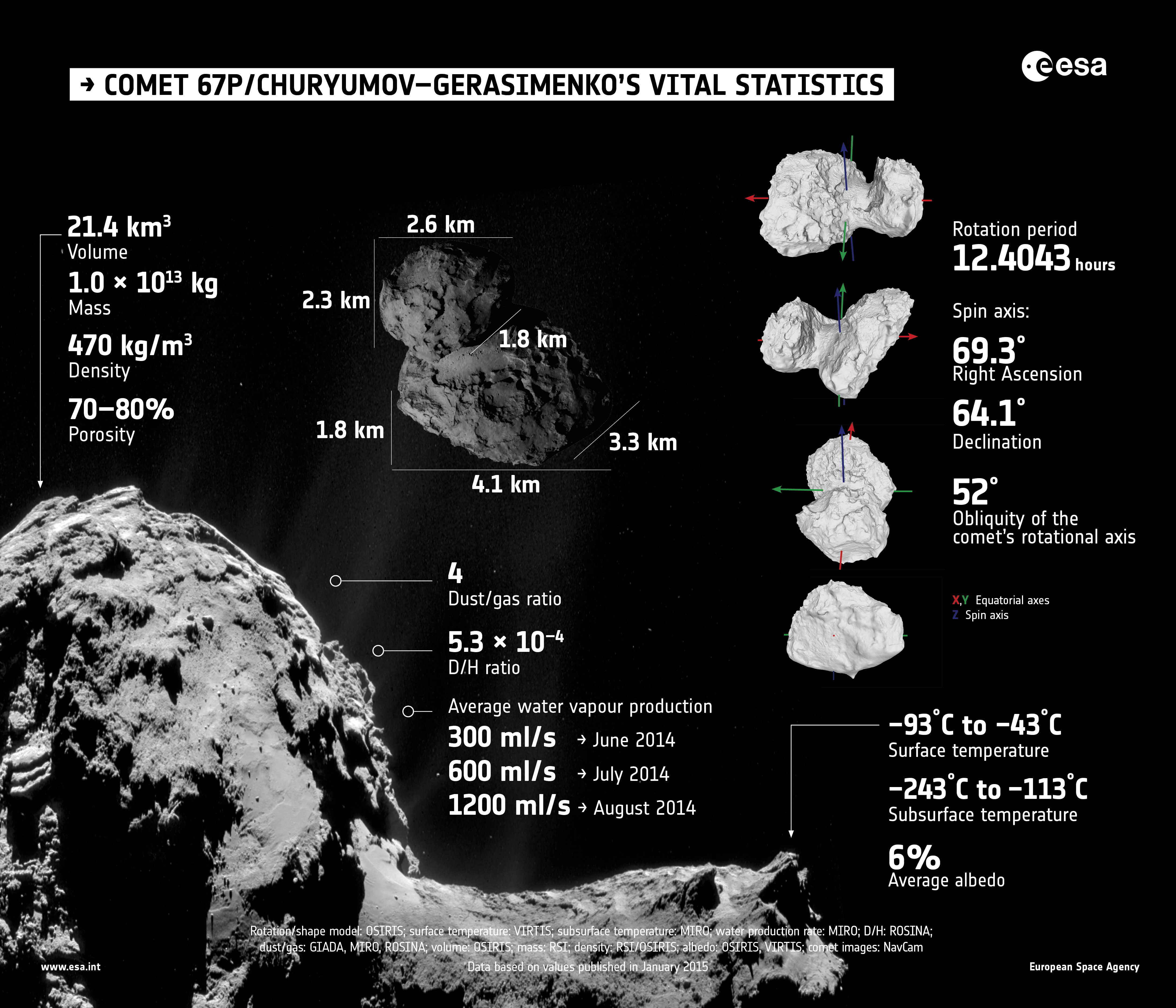
Concerning the dual-lobed comets vital statistics:
The small lobe measures 2.6 × 2.3 × 1.8 km, and the large lobe measures 4.1 × 3.3 × 1.8 km.
The total volume of the comet is 21.4 km^3, and its mass was measured to be 10 billion tonnes, or 10^13 kg. That’s about 100 million times the mass of the International Space Station (ISS), says Taylor.
From these data the density was derived to be very low, at 470 kg/m^3, less than half that of water.
That’s as expected and about like cork, which means the comet would float on water.
The comet interior is likely comprised mostly of weakly bound clumps of water ice and dust with voids in between, is fluffy, and therefore has a very high porosity of 70 to 80 percent.
“The nucleus surface itself appears rich in organic materials, with little sign of water ice,” says Taylor.
The measured rate of water gas production from sublimating ices generally increased about four fold from June to August, up to 4 × 10^25 molecules per second. But its varies widely depending on diurnal and seasonal changes.
Other molecules detected include H217O, H218O, CO, and CO2, and vary over time.
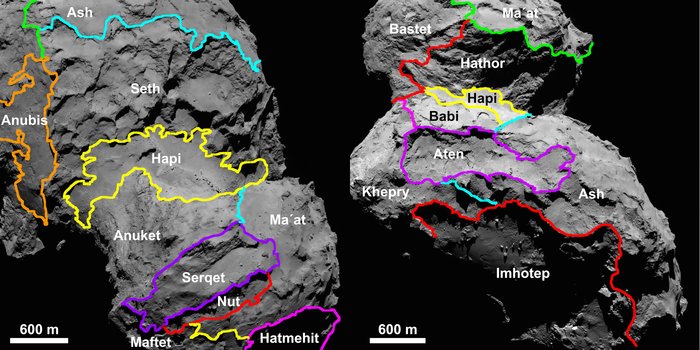
As reported previously, Rosetta’s ROSINA instrument measured a very high deuterium to hydrogen (D/H) ratio in the water, 5.3 × 10−4. That’s about 3 times higher than on Earth and means that Earth’s ocean water did not come predominantly from Jupiter family comets like 67P.
“Our finding also rules out the idea that Jupiter-family comets contain solely Earth ocean-like water,” says Kathrin Altwegg, principal investigator for ROSINA and lead author of a paper reporting the results in the journal Science.
“It supports and adds weight to models that include asteroids as the main delivery mechanism for Earth’s oceans.”
Rosetta is escorting comet 67P around the Sun as it swoops in closer, reaching perihelion in August 2015 at a distance of 186 million kilometers, between the orbits of Earth and Mars.
The probe will scrutinize the comet and its composition in detail as its outgassing activity of gas and dust significantly increases to form an expanding coma.
The Rosetta mission is expected to last until the end of 2015 and may well extend into 2016. Its longevity likely depends on when the finite maneuvering fuel runs out or the solar panels can’t generate enough power from diminishing sunlight during the outbound voyage.
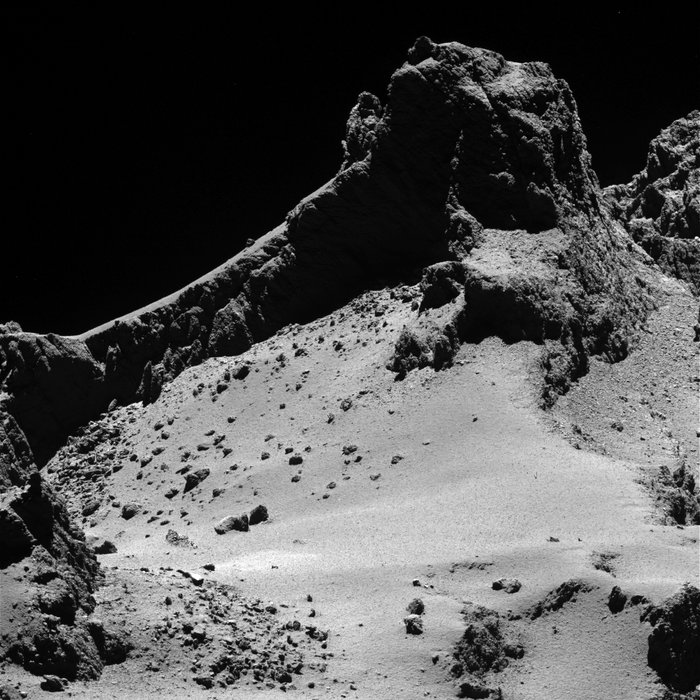
Watch for a discussion of more Rosetta discoveries in Part 2.
Stay tuned here for continuing developments.
Want to keep up-to-date with all things space? Be sure to “Like” AmericaSpace on Facebook and follow us on Twitter: @AmericaSpace
